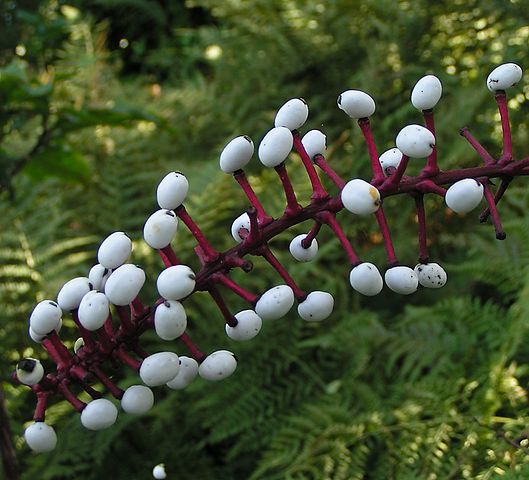Actaea pachypoda – White Baneberry
Actaea pachypoda
(AK-tee-uh pak-ee-POD-uh)
White Baneberry
The foamy appearance of the white-flowered Actaea pachypoda resemble Tiarella cordifolia, but are taller and have excellent interest after flowering has concluded. White Baneberry can be used in conjunction with the shorter Tiarella cordifolia as a transition to the back of a shade border. Both plants begin blooming around May and their varied sizes can create an undulating appearance of waves.
Garden interest of White Baneberry is extended through the fall with its pea-sized fruit. The attractive white spherical berries are held on red spikes, where the alternate common name of Doll’s eyes originates from. There are black and red fruit cultivars available if your planting scheme requires a different color echo. However, be conscious of the placement of Doll’s Eyes as the fruits are toxic and can be eaten by curious children or animals. Actaea pachypoda can be considered a low maintenance perennial as the foliage maintains excellent appearance until senescence in autumn and since the poisonous characteristics of the fruit are neglected by foraging animals, it persists on the plant until frost.
Origin:
Actaea – Latin name adopted by Linnaeus from Pliny, from Greek aktea or akte, elder.
pachypoda – Thick foot or stem.
Family – Ranunculaceae
Nativity – Eastern North America
Hardiness – USDA Zones 3-7a

Actaea pachypoda fruit
Description:
Form – Temperate woodland plant. Clump forming and growing between 2′-3′ tall.
Foliage – 13″-15″ long stems of foliage. Green, alternate, ternately compound, each lobe deeply toothed similar to Astilbe and Sambucus. Leaves remain in good appearance into late summer.
Flower – Fringed, fluffy white bottle-brush like flowers resemble the foam created by crashing waves. These dense, upright, long-peduncled, terminal raceme flowers bloom from May until late June.
Fruit – The berries are pea-sized and rest on a red spike. When they ripen in fall, they are white with a pink/purple hue. The fruit of White Baneberry is poisonous.

Actaea pachypoda foliage Photo Credit – http://www.midwestgroundcovers.com
Culture:
Light – Shade to partial shade. With enough moisture, it will tolerate full sun.
Soil – Prefers woodland settings that have rich humus and semi-moist soils.
Propagation – Division in early spring or sow seeds in autumn in cold frames.
Landscape Use – Woodland gardens, shade borders. Use as an accent plant by showcasing both the berries and flowers. Good choice for informal and cottage gardens requiring minimal maintenance.
Comments – The berries are poisonous so be mindful of curious children and pets.
♥ Source your Actaea pachypoda from Beth Chatto Gardens.


